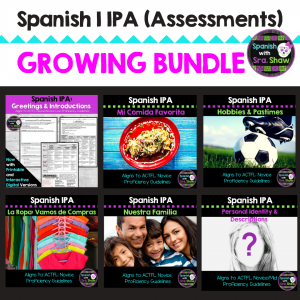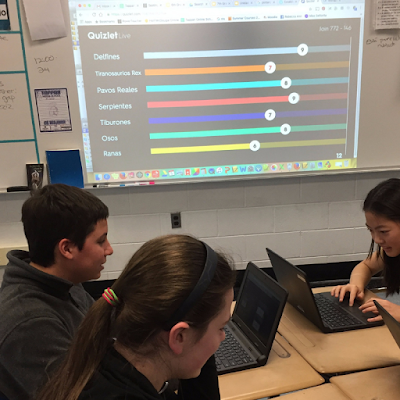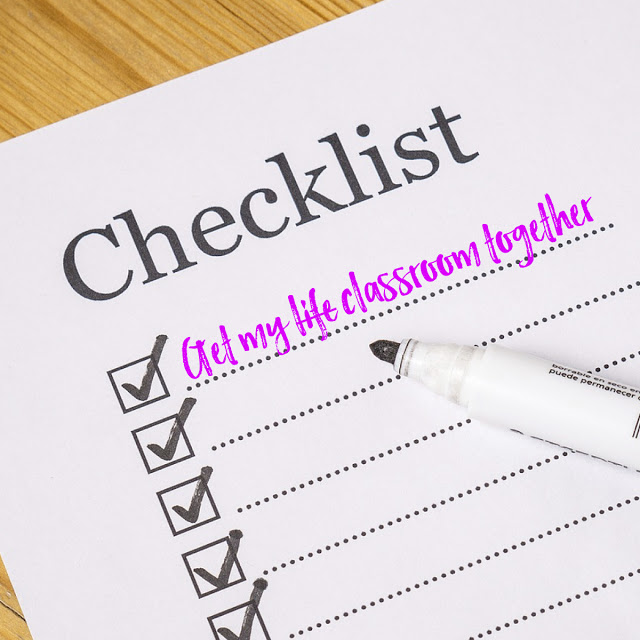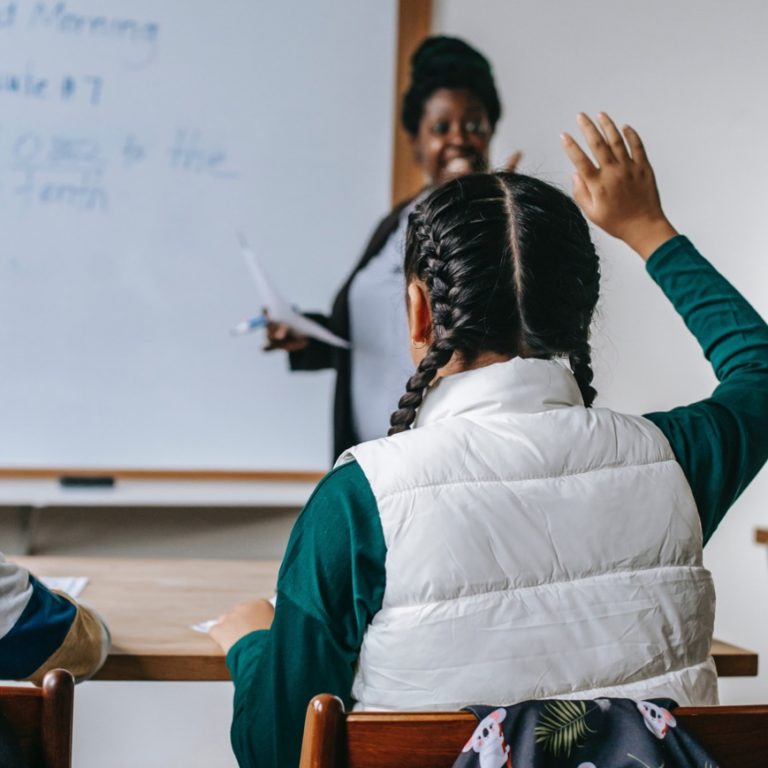
If you’d have told me in March that I’d spend the rest of the calendar year teaching my Spanish classes via distance learning, I’d probably have given you a crazy look and laughed. And yet here we are. I’m really excited to share some tips for the Spanish distance learning classroom.
Like so many of you, my district is starting the year with virtual learning. Honestly, I have no idea when or if we will go back to my physical classroom; I’m preparing to start the year in a completely different way than I have for the previous 16 years. In many ways, it’s like being a first year teacher. I’m having to adapt or completely change pretty much everything I do, but I wanted to share some tips for the distance learning Spanish (or World Language) Classroom.
1. Shift your expectations
With all of the changes, I’m refocusing and rethinking my philosophy on teaching. When I went to update my syllabus, I discovered that I needed to trash about 75% of what was in it. Many of my policies about classroom behavior, passes, late work, etc. somehow now seem completely irrelevant. I’ll have to adapt those expectations and learn as I go this year.
Virtual learning has even changed my grading policy. I decided to remove my vocabulary and grammar quizzes category because I know that students will cheat anyway. Homework? Everything is homework so I took out that category, which left me with my remaining categories (the three modes: interpretive, interpersonal, and presentational) and those will be worth 90% combined. The remaining 10% is for formative learning checks.
I’m excited about my new grading setup because it helps me focus on the modes of communication. Most importantly, my new grading policy is more equitable because it evens the playing field for my most at-risk students, who are less likely to do the smaller learning checks anyway.
Since I was throwing out most of the stuff in my old syllabus, I decided to go all out and design an interactive digital notebook style syllabus. It’s completely editable for your class policies, contains broad distance learning expectations, and makes a great first impression with your students and families. There’s also a pink version if you prefer. Check out its features in this video below:
2. Focus on relationships
Student relationships must come before our content this year, which is a hard pill for a curriculum fanatic like me to swallow. Usually I cringe at all of the get-to-know you activities at the beginning of the year, but after not seeing my students for so long, I’ve found myself craving a connection with my kiddos.
I want to get to know my new students and let them know that we will be speaking Spanish, but that we’re going to have fun and that I’m here to support them. After reading all of the positive reviews from Spanish teachers who’ve already implemented this both in physical or virtual classrooms, I can’t wait to try this new Google-based (with optional Pear Deck integration) ice breaker activity during the first week of school!
If you’re looking for even more ways to build relationships with your students from a distance, check out this great post from Dianna (La Profe Plotts) and even more awesome ice-breakers from Elisabeth (Spanish Mama).
3. Get that second monitor
Seriously, a second monitor is a game changer. As you teach your students in Zoom, Google Hangouts, etc., you can easily set up your monitors so that you see your students on one screen and whatever you’re presenting on another. We went into teaching so we can see our students learn, but if we can’t see our kids because a Google Slide is blocking their faces, what’s is the point?
With a second monitor, you’ll be much more efficient. After just one week with a second monitor, I don’t know how I’ll ever go back to one screen. Keep in mind that you don’t need to spend a fortune because you can get a decent monitor for under $100. Think about asking your family and friends on social media if they have an old one gathering dust or you can even use a small TV.
4. Make things easier on yourself
Apparently, 2020, COVID, and distance learning were destined to be the combination of things that finally made me stop grading ALL.OF.THE.THINGS. This year, I’m going to focus on what matters, and my mental health and family time is more important than if a kid completes every learning opportunity I assign.
On thing I’m going to do is to stop grading so many excess assignments. No more vocabulary or grammar quizzes. No more grading of every homework assignment. Based on Rebecca Blouwolff talks in her amazing NECTFL presentation, “We’ll Always Have Paris: Adapting Strategies for the New Now,” I’ll focus on interpretive mode, some speaking activities, and I’ll reduce the amount of presentational writing (kids are just going to use Google Translate anyway). Specifically, I plan to use a lot of my interpretive activities resources and my IPA bundle (images below).
I also plan to use as many self-grading activities as possible. A prime example of that is my Greetings and Introductions Interpretive Activities (image below), which features a self-grading Google Form or interactive digital worksheet. Similarly, I’ll use Quizizz, GoFormative, and Boom Cards.
 |
 |
 |
5. Practice Zoom teaching beforehand
Yesterday as part of our professional development, our district asked us to try out a couple of lessons virtually in groups of three. It was eye opening to see how differently Zoom handled as a teacher versus as a participant. We practiced breakout rooms, entering breakout rooms to check in, polls, and sharing our screens. If you’re using Google Slides, be sure to try out “presenter view” instead of the generic “present,” and if you’re using things like Quizizz, PearDeck, Edpuzzle Live, and Kahoot, be sure to practice those. I found that I had to play around with Pear Deck a bit and that I actually didn’t realize I could start my Pear Deck from my Google Slides page. Game changer!
So gather 2-5 colleagues, friends, or family members and test it out! After all, practice makes perfect and we’re new at this.
6. Find a supportive teacher group
Flat out, I would not have made it through last Spring if it weren’t for my district colleagues. We shared lessons, vented to one another, and generally supported one another. I’m super lucky to work with amazing WL colleagues in a large district, but the majority of us aren’t so lucky. So often we’re the only Spanish teacher or there are only a few others and it’s easy to feel isolated.
It’s been amazing to see all of the virtual groups popping up! One of my favorites has always been the Facebook group “Spanish Teachers in the US,” but lately, I’ve been enjoying smaller, more intimate groups like “Spanish 1 Teachers” because I don’t just want resources and ideas, but a connection with other teachers like me.
Another great option is your state World Language organization. I’m part of MIWLA, the Michigan World Language Association, and we’ve started doing virtual café hours to connect teachers and help them share resources. Also, since most state organizations are hosting online conferences this year, prices are lower and you don’t have to worry about a sub, so it’s the perfect year to connect with more WL teachers in your state.
7. See this as an opportunity
Please don’t hate me for saying that! You know that saying “you learn something new every day?” You’re going to learn so many new things every day, all school year long and while it is incredibly overwhelming, it’s also kind of awesome! Right? (By the way, I had to remind myself of this about 100 times before noon)
But really, I’m learning so many tools that when I do go back into the classroom, they are going to make me such a better teacher. Beyond the technological aspects, I’m learning about how to cut all of the extra stuff out of my curriculum, focus on my most important learning objectives, make my grading more equitable, and collaborate with more language teachers, even outside of my Spanish team. When I go back to the classroom, my teaching won’t be the same; it’ll be better!
8. Give yourself grace
So cliché, right? “Give yourself grace” is sure to be on the top list of teacher’s 2020 most hated phrases (if it’s not already), but it’s true. We are all going to mess up so many times this year. I think most teachers, especially our most senior or non-tech-savvy teachers, are being asked to learn more in a 6 month period than all of our previous years combined. As a self-proclaimed EdTech enthusiast, I keep thinking to myself that if I feel overwhelmed beyond belief, than how many of my colleagues are crying with their camera off trying to figure all of this out before our first day with students?
Have a great year, amigos! I hope these tips for the Spanish distance learning class help make your school year awesome! It just might be way better than you ever imagined!
Con abrazos,












No Comments